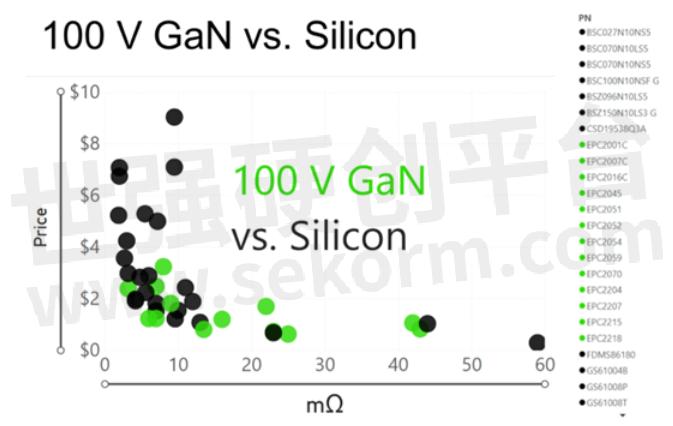EPC Share Some Myths about Gallium Nitride Semiconductors

Gallium nitride (GaN) has emerged as the technology to offer greater efficiency, significantly reduce system size and weight, and enable entirely new applications not achievable with silicon. So, why do so many myths still prevail about GaN and what are the facts?

One of the reasons so much misinformation persists about GaN is that suppliers of the incumbent silicon technology use scare tactics including rumors of reliability problems, design challenges, high prices, and unreliable supply chains to dissuade potential GaN users.
Despite these attacks, GaN continues to gain acceptance not only in enabling applications such as lidar but into traditional applications where the silicon MOSFET previously held the dominant position, like data centers and vehicle electronics. This article will debunk the most common myths about GaN and show how GaN FETs and GaN ICs are creating a displacement cycle in power conversion.
Myth #1: GaN technology is new and untested
Gallium nitride is a very hard, mechanically stable wide bandgap semiconductor first deployed in the early 1990s in the production of high-power/high-frequency RF transistors and light-emitting diodes (LEDs). In 2010, the first enhancement-mode GaN transistors became generally available that were designed to replace silicon power MOSFETs followed shortly after by GaN Power ICs which monolithically integrate a GaN FET, GaN-based drive circuitry and circuit protection into a single device.
The earliest adopters of GaN-based FETs and ICs were those taking advantage of the ability for GaN devices to switch about 10 times faster than MOSFETs and 100 times faster than IGBTs. For example, lidar systems for autonomous cars, robots, drones, and security systems were among the first volume applications to take full advantage of GaN’s high-speed switching ability.
As production volumes have grown, GaN is displacing the silicon MOSFET in traditional applications such as 48V DC-DC power supplies offering state-of-the-art power density and efficiency for data centers and other high-density computing solutions like cloud computing, artificial intelligence, machine learning, and gaming.
Myth #2: GaN technology is not reliable
GaN devices have been in volume production since early 2010 and have demonstrated extreme robustness in both laboratory testing and high-volume customer applications. With hundreds of billions of device hours in the field, EPC devices have shown a failure rate that is 100 times better than MOSFETs!
The reliability myth persists despite the fact that wide bandgap devices are less sensitive to temperature than silicon, chip-scale devices have fewer failure mechanisms than packaged devices, and GaN devices have achieved automotive certification and space heritage.
With a ‘test to fail’ approach to reliability testing, EPC tests GaN devices well beyond the JEDEC standard to improve robustness generation after generation. This methodology identifies intrinsic failure mechanisms that are used to develop physics-based models to accurately project the safe operating life of a product over a more general set of operating conditions so designers can evaluate based on their specific use case.
The results of the test-to-fail report can be found here: GaN Reliability.
Myth #3: It’s difficult to design with GaN components
GaN devices behave similarly to power MOSFETs but there are some things to keep in mind when designing GaN circuits. For one, GaN devices are 10 x faster than silicon MOSFETs, and as a result, circuits that use GaN are more sensitive to parasitic inductance. Parasitic inductance causes ringing and overshoot which adds EMI and risk of circuit failure. However, the minimization of parasitic inductance is straightforward. A properly designed GaN circuit has less EMI and overshoot than the best possible MOSFET design.
Due to the extreme performance advantages that GaN provides, the ecosystem to support these designs continues to expand with an ever-increasing number of suppliers releasing components such as gate drivers, controllers, and passive components that further enhance GaN the performance of GaN-based systems.
Further, GaN’s intrinsic ability to integrate multiple devices on the same substrate will allow monolithic power systems to be designed on a single chip in a more straightforward, higher efficient, and more cost-effective way. Integrated power stages, such as the EPC23102, give designers a solution that is 35 % smaller, uses 50% fewer components, requires less design time, and provides better efficiency compared to discrete implementations. GaN integrated circuits make products smaller, faster, more efficient, and easier to design.
Myth #4: The supply chain for GaN is unreliable
The manufacturing process for EPC’s GaN FETs and ICs is quite simple and mature. By growing a GaN epi layer on top of silicon, the existing silicon manufacturing supply chain can be used to eliminate the need for costly specialized production sites. The supply chain leverages readily available, large-diameter, silicon wafers for high-volume production at low cost, and high-volume backend production with established and tested partners. Since the individual devices are much smaller than silicon devices, many more GaN devices can be produced per wafer, providing a high-volume, low-cost, mature, responsive, highly scalable supply chain.
Myth #5: GaN FETs and ICs are expensive
This is the most common myth about GaN technology! GaN devices have been on the market since about 2015 that are lower in price when compared with silicon power MOSFETs with the same on-resistance and voltage ratings. This trend has continued since then as production volumes increased, while at the same time, technology has improved, and die-shrinks have been achieved. The chart below shows a comparison of prices for EPC’s 100 V GaN FETs and their MOSFET counterparts at various on-resistance specifications.

This comparison does not even consider system-level costs. As an example, in a 3 kW 48 V to 12 V DC-DC converter for automotive electric systems, the fast-switching speed of GaN allows a solution that can operate at a higher frequency and higher efficiency enabling a reduction in the number of required phases from a five-phase MOSFET system to a four-phase GaN system that is 35% smaller and lower cost.
Myth #6: GaN technology is not ready for widespread adoption
GaN started commercial production in March of 2010, and lidar was the first ‘killer app’ to use the high speed and tiny size of GaN transistors to maximize performance. This was soon followed by 48V DC-DC converters for high-density computing. Satellite systems began using GaN FETs in volume as they became aware of the excellent properties of GaN in environments that involve multiple forms of radiation. Hundreds of thousands of GaN FETs and hybrid modules have obtained flight heritage everywhere from low Earth orbit to the more stringent geosynchronous Earth orbit. High voltage (650V) GaN FETs and ICs from companies such as Navitas Semiconductor, Power Integrations, and GaN Systems developed the first high-volume consumer market for GaN, the cellphone fast charger. E-bikes, drones, and robots soon adopted GaN to reduce weight, size, cost, and EMI. Automotive applications such as 48 V DC-DC converters, headlamps, cabin fans, seat heaters, and onboard chargers are all moving towards GaN as volumes increase, reliability is proven, and prices decrease.
At this point, GaN is no longer a ‘science project’, but a broad-scale replacement for silicon MOSFETs in applications ranging from 15 V up to 650 V.
Conclusion
Today’s GaN technology is improving rapidly in performance, reliability, and cost and the current benchmark devices are still 100s of times away from their theoretical performance limits. Incumbent MOSFET suppliers, recognizing their products are near their performance limits and a viable competitive solution is gaining acceptance, are using scare tactics to perpetuate myths about GaN.
GaN has emerged as a broad-scale replacement for silicon offering greater efficiency, smaller size, higher reliability, and lower cost. At this point, there are a few reasons not to use GaN FETs and GaN ICs. Learn more about the future of GaN technology, or speak directly with a GaN Expert to get started on your design.
- +1 Like
- Add to Favorites
Recommend
- EPC‘s 100V, 35A eGaN IC EPC23102 Boosts Power Density and Simplifies Design
- EPC23102 ePower™ Stage GaN IC Shrink Motor Drives and Speed Time-to-Market for eMobility, Power Tools, Robotics, and Drones
- The 150V, 3mΩ EPC2305 and the 200V, 5mΩ EPC2304 GaN FETs offering higher performance and smaller solution size
- 200V, 10mΩ GaN FET EPC2307 Joins Family of Footprint Compatible QFN Packaged Devices for High Efficiency and Design Flexibility
- EPC GaN ICs Simplify Motor Joint Inverter Design for Humanoid Robots
- 65A ePower™ Chipset from Efficient Power Conversion (EPC) Redefines Power Conversion
- Sharge Selects GaN FETs EPC2218 from EPC for High-power USB PD Charger Retro 67 to Achieve the Most Efficient Power Conversion
- Epc Expands Its Family of Footprint Compatible Epower™ Stage ICs to Boost Power Density and Simplify Design for Different Power Requirements
This document is provided by Sekorm Platform for VIP exclusive service. The copyright is owned by Sekorm. Without authorization, any medias, websites or individual are not allowed to reprint. When authorizing the reprint, the link of www.sekorm.com must be indicated.





























































































































































































































































































































































































































































































































































































































































































































































































































































































